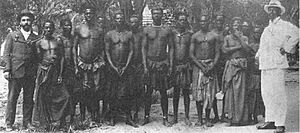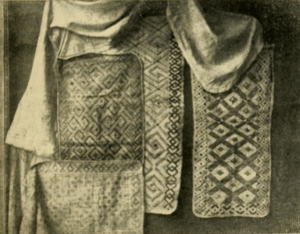William Henry Sheppard facts for kids
Quick facts for kids
William Henry Sheppard
|
|
|---|---|
 |
|
| Born | March 8, 1865 Waynesboro, Virginia, U.S.
|
| Died | November 25, 1927 (aged 62) |
| Education | Hampton Institute Tuscaloosa Theological Institute (Stillman College) |
| Occupation | Presbyterian missionary |
| Known for | Missionary work in the Congo and reporting the exploitation of the Congolese by Leopold II of Belgium |
William Henry Sheppard (March 8, 1865 – November 25, 1927) was one of the first African Americans to become a missionary for the Presbyterian Church. A missionary is someone who travels to another country to share their religious beliefs and help people.
Sheppard spent 20 years in Africa, mostly in a place called the Congo Free State. He became famous for telling the world about the terrible things happening to the Kuba people and other groups in the Congo. These awful acts were committed by the army of King Leopold II of Belgium.
Sheppard's work helped people talk about how European countries were taking over and controlling parts of Africa. His efforts were especially important to the African-American community.
Contents
Early Life and Education
William Henry Sheppard was born in Waynesboro, Virginia, on March 8, 1865. This was just before the end of the American Civil War. His parents were William Henry Sheppard, Sr. and Fannie Frances Sheppard. His father was a barber, and his family was considered well-off for Black families at that time.
When William Jr. was twelve, he worked as a stable boy for a white family. He liked this job and stayed in touch with the family for many years. Later, he worked as a waiter to pay for his studies at the Hampton Institute. Here, he worked during the day and took classes at night. One of his teachers was Booker T. Washington.
Sheppard loved the "Curiosity Room" at Hampton Institute. This room had a collection of art from Native Hawaiian and Native American cultures. This made him appreciate different cultures. Later, when he was in the Congo, he collected artifacts from the Kuba people to bring back for this room.
After graduating, Sheppard went to Tuscaloosa Theological Institute (now Stillman College) in Alabama. He wanted to become a preacher in Africa. Even though his church supported him, they hadn't started a mission in the Congo yet. He became a pastor in Atlanta, Georgia, in 1888. However, he found it hard to live as a Black man in the segregated South.
Sheppard kept writing to the Presbyterian Foreign Missionary Board, asking to start a mission in Africa. After two years of being turned down, he went to Baltimore to ask in person. He was told that the board would not send a Black man without a white supervisor.
Finally, a white man named Samuel Lapsley, who was eager to go to Africa, helped Sheppard. They decided to send both white and Black missionaries together, with equal rights. This was a new and important idea at the time.
Journey to the Congo
Sheppard and Lapsley's journey to Africa was even helped by King Leopold II himself. In 1890, they traveled to London on their way to the Congo. Lapsley met General Henry Shelton Sanford, who was a friend of King Leopold II. Sanford promised to help them and even arranged a meeting with the King in Belgium.
King Leopold II was not interested in their religious work. However, he wanted them to go to his new territory in the Congo. He hoped they would help "civilize" the local people and make his rule seem more fair. The missionaries did not realize the King's true intentions.
Sheppard and Lapsley arrived in Leopoldville. Sheppard quickly saw the local people differently from other foreigners. Even though he was of African descent, the locals called him "Mundele N'dom," meaning "black white man." At first, Sheppard held some common ideas that African natives were "uncivilized." But his views quickly changed.
He wrote in his journal: "I grew very fond of the Bakuba and it was reciprocated. They were the finest looking race I had seen in Africa, dignified, graceful, courageous, honest, with an open smiling countenance really hospitable. Their knowledge of weaving, embroidering, wood-carving and smelting was the highest equatorial Africa."
Sheppard was more interested in exploring than just being a missionary. While Lapsley was away, Sheppard learned the local hunting techniques and language. He even helped prevent a famine by hunting many hippos. Sheppard got malaria 22 times in his first two years in Africa.
Meeting the Kuba People
By 1892, Sheppard knew the Kuba language and culture well. He took a team to the edge of the Kuba territory. He used clever tricks to get further into the kingdom. For example, he ate so many eggs that the villagers couldn't supply them anymore, which allowed his scout to go to the next village to find more.
Eventually, he met villagers who would not let him go further. Then, the king's son, Prince N'toinzide, arrived and arrested Sheppard and his men for trespassing.
Instead of punishing Sheppard, King Kot aMweeky told his village that Sheppard was his deceased son. The King declared Sheppard "Bope Mekabe," which saved Sheppard's life and his men's lives. This was a smart move by the king. He was in danger of losing his power, so he used the arrival of strangers to distract people.
During his stay, Sheppard collected many artifacts from the Kuba people. He also got permission to start a Presbyterian mission there. The king let him leave, but only if he promised to return in one year. However, Sheppard could not return for several years. By then, King Kot aMweeky had been replaced by a new leader.
Exposing Congo Free State Abuses
In the late 1800s, King Leopold II started getting a lot of criticism for how he treated the people in the Congo Free State. In the United States, the Presbyterian church was a main voice against these actions.
In 1891, after Lapsley's death, Sheppard teamed up with another missionary named William Morrison. They decided to report the terrible crimes they saw. Later, with the help of Roger Casement, they formed the Congo Reform Association (CRA). This was one of the world's first groups dedicated to human rights.
In January 1900, The New York Times published a report based on Sheppard's findings. He had visited a camp where warriors, sent by the Congo Free State, had attacked villages to collect taxes. Sheppard saw shocking evidence of violence. He counted 81 right hands that had been cut off and were being dried to show the State officers what the warriors had done. He also found 60 women held captive. This report caused a huge outcry against the Congo Free State.
When Mark Twain wrote his famous book King Leopold's Soliloquy five years later, he mentioned Sheppard by name and his account of the massacre.
In 1908, Sheppard wrote another report about the abuses in a mission newsletter. Because of this, he and Morrison were sued for libel by a powerful Belgian rubber company. When the case went to court in 1909, the missionaries had support from the CRA and their lawyer, Emile Vandervelde. The judge found Sheppard not guilty. It is believed that international pressure played a role in the decision, as the U.S. government was questioning King Leopold II's rule over the Congo.
Sheppard's reports often showed that the State's actions broke laws set by European nations. Many of the cruel acts he documented went against the Berlin Act of 1885. This act gave Leopold II control over the Congo, but only if he promised to improve the lives of the people and help stop slavery.
Sheppard's Lasting Impact
Sheppard's efforts were very important in the discussions about European control in Africa, especially among African Americans. However, many historians say he has not received enough recognition for his contributions.
During his time in the Congo, Sheppard collected a large amount of Kuba art. He gave much of it to his old school, Hampton University. This collection is now on display at the Hampton University Museum. He might have been the first African American to collect African art. His collection was special because he gathered the art directly from Africans in their daily lives. Kuba art is known as one of the most developed forms of African visual art.
Sheppard's collection was also very helpful to scientists who study cultures. The Kuba culture was not well known to the outside world at the time. For example, his collection showed that Kuba art did not have many human figures or statues of gods. This suggested that their religion might not have been expressed through art in the same way as other cultures. A journal called Southern Workman wrote that his collection "not only meets the requirements of the ethnologists, but those of the artist as well."
Images for kids










